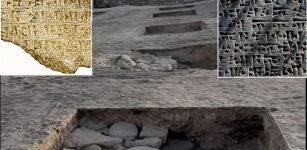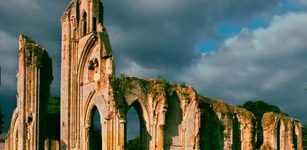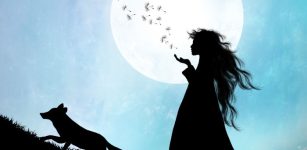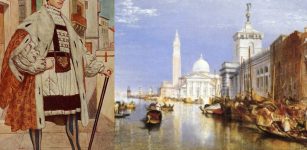Pytheas’s Voyage To The Arctic In 325 B.C. And Account Of Thule, The Strange Land Beyond
Jan Bartek - AncientPages.com - Who was the first explorer to visit the Arctic? That is a question one cannot answer quickly. The lack of historical references dealing with early Arctic exploration and difficulties interpreting early maps and accounts of voyages challenge our understanding of the historical period during which explorers reached the region north of the Arctic Circle.
Also, exploring dangerous territories like the Arctic may end with death. There could have been many people who traveled to the Arctic but never survived to tell their story.
Pytheas of Massalia (350 B.C. – 285 B.C.) described his voyage to the Arctic in a work that has not survived. Can his claims be substantiated?
He also reported a strange land in the North that is today referred to as Thule. Where could this mysterious land be located?
Pytheas was a Greek geographer, explorer, and astronomer. Today, he is considered the first known scientist who visited and described the Arctic, polar ice, and the Celtic and Germanic tribes. Being a good astronomer, Pytheas was also the first person to provide the world with a description of the Midnight Sun.
Pytheas's Account Of Thule Fascinated People
The accounts of Pytheas were discredited for centuries, but Thule's idea captured the imagination of many who longed to learn more about this mysterious land in the North.
"Since classical times, Thule marked the imaginative horizon of the unknown North, first described by Pytheas of Massalia, who in the third century B.C. reported on a strange place far north ('six days sail north of Orcades') where the sun would never set in the summer and where the ocean was solid frozen. Nobody knows for sure how far north Pytheas went himself and how much he relied on secondary knowledge in his own (lost) descriptions of this place." 1
Pytheas stated Thule was inhabited by people whom he called the Hyperboreans. He also said they live on an island in the North of Britannia. It is a place "beyond the north wind." Later Greek and Roman authors such as Pliny, Pindar, and Herodotus described the Hyperboreans as happy people who had exceptionally long lifespans and did not suffer from illness.
"With shining laurel wreaths about their locks (of hair), they hold feasts out of sheer joy. Illnesses cannot touch them, nor is death foreordained for this exalted race," Pindar wrote about the Hyperboreans 2
Pytheas introduced the idea of distant Thule to the geographic imagination, but the island he spoke about has never been located despite the clues left by the Greek explorer.
Ancient Greeks' Knowledge Of Life In The North Was Limited
"When Pytheas set out from Massalia no one in the Greek world knew answers to questions like: How far north could people really live? How cold would it really get? Could the trend for increasing length of days during the summer extend to 24-hour sunlight? Was there a place beyond which climate improved again, a climate in which the Hyperboreans could be living? Could the world have an 'edge' at all?
Pytheas' answers to these questions were so out of keeping with the established beliefs of Classical Europe that his critics labelled him a fabulist and a charlatan. He denied the misconceptions of the North then currently held in Greece, such as that one-eyed Arimaspians danced with the Hyperboreans there, and stole gold from the nests of gryphons. He said that on the contrary the Britons were people like the Greeks." 3
Map showing the hypothetical route followed by Piteas. The most doubtful sections of the route are marked with a broken line. It is unknown how far north he sailed. Credit: Fschwarzentruber - CC BY-SA 4.0
Pytheas's accounts of Thule led to countless speculations, and the idea that Thule was located on the northern edge of the inhabited world persisted.
"It was invariably where an "other" people lived as seen from the heartland of classical civilization. In the early Middle Ages, when Irish hermits and Norse Vikings began roaming the North Atlantic, Thule became located in Iceland, which was then as far as actual knowledge of the northern horizon went. When, soon afterwards, the settlers in Iceland had established their own canons of civilizations and moved onwards to "discover" Indians and Eskimos beyond the immediate horizon, the image of the northern barbarians once again was relocated." 1
Thule as Tile on the Carta Marina of 1539 by Olaus Magnus, where it is shown located to the northwest of the Orkney islands, with a "monster, seen in 1537", a whale ("balena"), and an orca nearby. Credit: Public Domain
From the day Pytheas of Massalia mentioned Thule for the first time, explorers have attempted to find this mysterious land, but all failed. Countless books have been written about Thule, and each author and researcher has presented their theory to try to explain the location of Thule. No one knows where this land exists or if it exists at all. Today, there is a place called Thule Island. Named after Captain Cook during his second voyage in 1775, it is one of three southernmost islands in the South Sandwich Islands. Still, this was not the Thule Pytheas described.
Pytheas's descriptions of foreign lands he visited may not have been 100% accurate, but what can one expect from an explorer of the 4th century who did not have access to detailed maps. Pytheas of Massalia contributed with information expanding our knowledge of geography, and many consider him the first known explorer in the modern sense of the word.
Updated on September 22, 2024
Written by Jan Bartek - AncientPages.com Staff Writer
Copyright © AncientPages.com All rights reserved. This material may not be published, broadcast, rewritten or redistributed in whole or part without the express written permission of AncientPages.com
Expand for references- Hastrup, Kirsten. "Ultima Thule: Anthropology and the Call of the Unknown." The Journal of the Royal Anthropological Institute13, no. 4 (2007): 789-804.
- The Northern Lights Route - The Council of Europe Cultural Routes: The voyage of Pytheas to Thule. University Library of Tromsø
- Francis Gavin - True North: Travels in Arctic Europe
More From Ancient Pages
-
 Monumental Structure Unearthed During Excavations Of Urartu-Era Karmir Blur
Archaeology | Nov 25, 2022
Monumental Structure Unearthed During Excavations Of Urartu-Era Karmir Blur
Archaeology | Nov 25, 2022 -
 Ancient City Of Timgad: Largest Roman Settlement Ever Built In North Africa
Civilizations | Feb 28, 2023
Ancient City Of Timgad: Largest Roman Settlement Ever Built In North Africa
Civilizations | Feb 28, 2023 -
 Medieval Mythbusting – New Research Rewrites History Of Glastonbury Abbey
Archaeology | Nov 23, 2015
Medieval Mythbusting – New Research Rewrites History Of Glastonbury Abbey
Archaeology | Nov 23, 2015 -
 Eurasian Horse Riders Played Ball Games 3,000 Years Ago – Leather Balls Found In Graves Reveal
Archaeology | Oct 12, 2020
Eurasian Horse Riders Played Ball Games 3,000 Years Ago – Leather Balls Found In Graves Reveal
Archaeology | Oct 12, 2020 -
 The Untold Story Of The Inca – Fire In The Sky – Part 1
Ancient Mysteries | Jul 2, 2019
The Untold Story Of The Inca – Fire In The Sky – Part 1
Ancient Mysteries | Jul 2, 2019 -
 4000-Year-Old Egyptian Leather Manuscript Forgotten For More Than 70 Years – Found
News | Sep 14, 2015
4000-Year-Old Egyptian Leather Manuscript Forgotten For More Than 70 Years – Found
News | Sep 14, 2015 -
 Puzzling Ancient Artifacts Found In Canadian Mountains Defy Explanation – Scientists Say
Featured Stories | Aug 27, 2024
Puzzling Ancient Artifacts Found In Canadian Mountains Defy Explanation – Scientists Say
Featured Stories | Aug 27, 2024 -
 Number Eight Powerful Symbol In Ancient Traditions Of Many Cultures
Ancient Symbols | Dec 8, 2017
Number Eight Powerful Symbol In Ancient Traditions Of Many Cultures
Ancient Symbols | Dec 8, 2017 -
 On This Day In History: King Alexander II Was Crowned At Scone, Scotland – On Dec 6, 1214
News | Dec 6, 2016
On This Day In History: King Alexander II Was Crowned At Scone, Scotland – On Dec 6, 1214
News | Dec 6, 2016 -
 Carved Symbols Related To The Galician Castro Culture Discovered At Castro de San Vicenzo, Orense, Spain
Archaeology | Oct 11, 2024
Carved Symbols Related To The Galician Castro Culture Discovered At Castro de San Vicenzo, Orense, Spain
Archaeology | Oct 11, 2024 -
 Algonquin People And The Myth Of The Medicine Woman In The Moon
Featured Stories | Feb 1, 2016
Algonquin People And The Myth Of The Medicine Woman In The Moon
Featured Stories | Feb 1, 2016 -
 Surprising Discoveries In Mysterious Giant Viking-Era Cave In Iceland Can Confirm Norse Sagas
Archaeology | May 31, 2022
Surprising Discoveries In Mysterious Giant Viking-Era Cave In Iceland Can Confirm Norse Sagas
Archaeology | May 31, 2022 -
 On This Day In History: Treaty of Bergerac Ratified – On Sep 17, 1577
News | Sep 17, 2016
On This Day In History: Treaty of Bergerac Ratified – On Sep 17, 1577
News | Sep 17, 2016 -
 Unexpected Discovery Reveals People Arrived In North America 20,000 Years Earlier Than Previously Thought
Archaeology | Jun 5, 2021
Unexpected Discovery Reveals People Arrived In North America 20,000 Years Earlier Than Previously Thought
Archaeology | Jun 5, 2021 -
 Ancient Venetian Merchants Were Always Prepared For The Worst
Featured Stories | Jul 12, 2024
Ancient Venetian Merchants Were Always Prepared For The Worst
Featured Stories | Jul 12, 2024 -
 Giant Solar Mirrors And Sophisticated Lenses – Advanced Ancient Technology Used By Our Ancestors
Ancient Technology | Jun 15, 2020
Giant Solar Mirrors And Sophisticated Lenses – Advanced Ancient Technology Used By Our Ancestors
Ancient Technology | Jun 15, 2020 -
 Ancient Riddle Solved – Why Was Roman Concrete So Durable?
Archaeology | Jan 7, 2023
Ancient Riddle Solved – Why Was Roman Concrete So Durable?
Archaeology | Jan 7, 2023 -
 On This Day In History: Battle Of Lagos Took Place Between Royal Navy Of Britain and France – On August 19, 1759
News | Aug 19, 2016
On This Day In History: Battle Of Lagos Took Place Between Royal Navy Of Britain and France – On August 19, 1759
News | Aug 19, 2016 -
 On This Day In History: Hubble Space Telescope Was Launched – On April 24, 1990
News | Apr 24, 2016
On This Day In History: Hubble Space Telescope Was Launched – On April 24, 1990
News | Apr 24, 2016 -
 On This Day In History: Soviet Spacecraft Venera 7 Launched: First To Send Data From Venus To Earth – On Aug 17, 1970
News | Aug 17, 2016
On This Day In History: Soviet Spacecraft Venera 7 Launched: First To Send Data From Venus To Earth – On Aug 17, 1970
News | Aug 17, 2016



